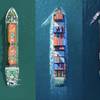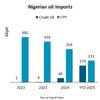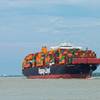U.S.-Flag Cargo Movement on Lakes Slows
The U.S.-Flag Great Lakes fleet hauled 11.1 million net tons of cargo in October, a slight decrease from both a year ago and the month’s 5-year average.
The downturn in steel production did not translate into a drop in iron ore cargos in October. Loadings in U.S. bottoms actually increased by 160,000 net tons. However, five U.S.-Flag Lakers are now laid-up for the year, primarily because of the slowdown at the nation’s steel mills.
The dredging crisis also impacted cargo totals. With the water level on Lake Superior receding, the largest vessels were trimming some 2,000 tons off their loads compared to just a month ago. The U.S. Army Corps of Engineers needs to remove 17 million cubic yards of sediment from ports throughout the system, but Federal funding remains inadequate. Restoring the Great Lakes navigation system to project dimensions would provide a real economic stimulus to the economy at no additional cost to the taxpayer or Federal government. The Harbor Maintenance Trust Fund (HMTF) that pays for dredging with taxes on waterborne commerce has a surplus of nearly $5 billion.
The Lakes dredging crisis could be solved with an allocation of about $230 million, or less than 5 percent of the surplus in the HMTF. For the year, U.S.-Flag carriage stands at 85.2 million net tons, a slight increase (200,000 net tons) compared to a year ago, but down about 1 percent (or 800,000 net tons) from the 5-year average for the January-October timeframe.












